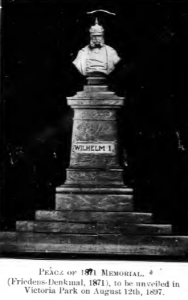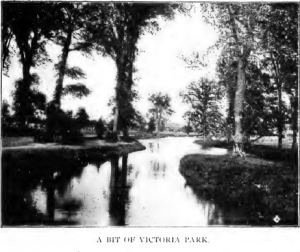The end of the Franco-Prussian War in 1871 resulted in the unification of the German States into a United Germany under Kaiser Wilhelm I, the King of Prussia. On 2 May 1871, Citizens of Berlin, Ontario flooded the streets to celebrate the end of the European conflict in the form of a Friedensfest, or “Peace Festival.” They celebrated through parades, speeches, music, mass-choir singing, and fireworks. German clubs from throughout Canada and the United States, gathered alongside citizens of Berlin, and planted an oak tree to symbolize the end of the conflict.
In 1896, citizens gathered again to celebrate the twenty-fifth anniversary of Friedensfest. A year later, on 13 May 1897, a publicly funded monument was erected in Victoria Park in Berlin of Kaiser Wilhelm I, which was unveiled in a grand ceremony. The Friedensfest is an example of how the European German presence had vastly eclipsed that of the German Mennonite in Waterloo Region by 1871. This festival is also indicative of a growing “global village,” as citizens celebrated the end of a foreign conflict at home. Like the Säengerfest, the celebration of Friedensfest ended with the outbreak of the First World War.
(Friedensfest Denkmal Plaque, Kitchener, Ontario; Hayes, Geoffrey. “From Berlin to the Trek of the Conestoga: A Revisionist Approach to Waterloo County’s German Identity.” Ontario History 2, 1999: 131-150.)

